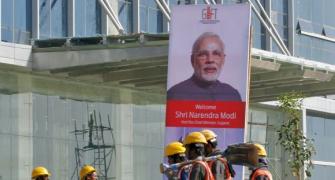On key issues of privatisation and subsidy reform, the government missed the opportunity to articulate a position that would mark a significant departure from the past, says Ishan Kumar Bakshi .

Many harboured the belief that Finance Minister Arun Jaitley’s Union Budget for 2015-16 would mark a decisive rupture from the past, that it would articulate a coherent, cogent right-of-centre economic ideology to counter the hegemonic Nehruvian narrative that had dominated policy discourse in India.
But though there were traces of a rightward shift in the budget, it seemed bereft of ideological moorings.
This hesitance, or reluctance, of a party that is avowedly socially and culturally rightist to articulate a centre-right economic ideology is mystifying.
On key issues of privatisation and subsidy reform, the government missed the opportunity to articulate a position that would mark a significant departure from the past.
On the issue of privatisation of public sector entities, although the finance minister has laid out an ambitious agenda of divesting the government’s stake with a proposed target of Rs 61,000 crore (Rs 610 billion) – a figure that no government, including this one, has ever met – he still proposes to continue subsidizing loss making PSUs such as Air India.
This is an ideologically contradictory position if the government fundamentally believes in rolling back the boundaries of the state.
The Prime Minister’s statement that government has no business of being in business remains a hallow pledge Subsidy reform was another area where the government could have staked out a different position.
To the extent that the present dispensation would curtail the programmes of the earlier regime and shift from universal schemes to targeted schemes, it would have been welcome.
But precious little was said on both food and fertiliser subsidy.
While there were references to so-called game changers such as the JAM trinity – Jan Dhan, Aadhar and Mobile – to implement the direct transfers, the Budget did not provide any roadmap or any clarity on the shift.
The interim report of the Expenditure Commission to rationalise government expenditure and the Shanta Kumar committee report which recommended shifting to cash transfers also found no mention in the speech. But to be fair, certain policy measures do indicate a shift in economic thinking.
The emphasis on increasing public investment marked a decisive shift away from the previous dispensation’s consumption-oriented approach.
Further, by accepting the recommendations of the 14th Finance Commission to devolve a higher share of untied funds to the states, the government has moved firmly in favour of economic federalism.
Though on the latter, the central government has ended up levying additional cess and surcharges, revenues it does not have to share with the states.
But the absence of a clear underlying economic ideology in the Budget – good governance is not an ideology, nor is development – has left many wondering whether the new government will indeed articulate a counter-narrative to the left-of-centre ideology the Congress has traditionally hewn to.
As one analyst put it: Is Modi indeed the libertarian they had hoped for?
Part of the yawning gap between expectations and reality stems from, as an economist who was part of the pre-Budget consultations at Niti Aayog puts it, “a misreading of Modi’s tenure at Gujarat and confusing what was essentially pre-election rhetoric with reality”.
Ardent supporters extrapolated statements like “Minimum government, maximum governance” and “Government has no business of being in business” to mean a rolling back of the frontiers of the state, equating Modi with torchbearers of the modern right such as Ronald Reagan and Margaret Thatcher.
But extrapolations never quite match up with reality.
“Modi seems more inclined to improving the performance and profitability of public sector undertakings by reducing political interference and giving managerial autonomy rather than relying on outright privatization. He believes that both the private sector and the public sector have important roles in well regulated market economy”, added the economist.
Another reason, a BJP spokesperson says, centres on keeping the faithful in check.
Articulating a genuine right-of-centre economic agenda he believes “is likely to provoke strong criticism from among others various sister organisations in the larger Parivar.”
Thus the compulsion of keeping the wider family in check and firmly behind the government would necessitate not having an explicit rightist ideology.
The other and probably the most critical reason, the spokesperson put forth, challenges the very notion that genuine right of centre political parties can flourish in India.
The reluctance he says stems from the line of thinking that, “no matter the size of the economy and growth rates, India is a poor country and thus doing away with subsidies and reducing the role of the government is likely to provoke a severe backlash.”
So to expect the government to abdicate its existing role and roll back the boundaries of the state is being politically naive.
This explanation also fits well with the government’s attempts to paint it as a pro-poor budget. The ghost of the India shining campaign looms large.
Thus while political pragmatism may trump ideological convictions, what is indeed surprising is making a virtue out of adopting an incrementalist approach.
If incrementalism is indeed the guiding principle, then the same could have been achieved with a Parliamentary of strength 182 (BJPs strength in Lok Sabha under Vajpayee), let alone 282.
The massive mandate the BJP received was a vote for a decisive break from the past.
In fact much of the pre-election rhetoric of the BJP centred on how big bang reforms and a radical departure from the past were predicated on the numerical strength of the party in the Lok Sabha.
So the question is what is the gain from the BJP having a majority by its own? What exactly is the political capital being saved for?










